Want to add color and charm to your favorite recipes? Use these edible flowers as garnishes and accents and impress your dinner guests every time!
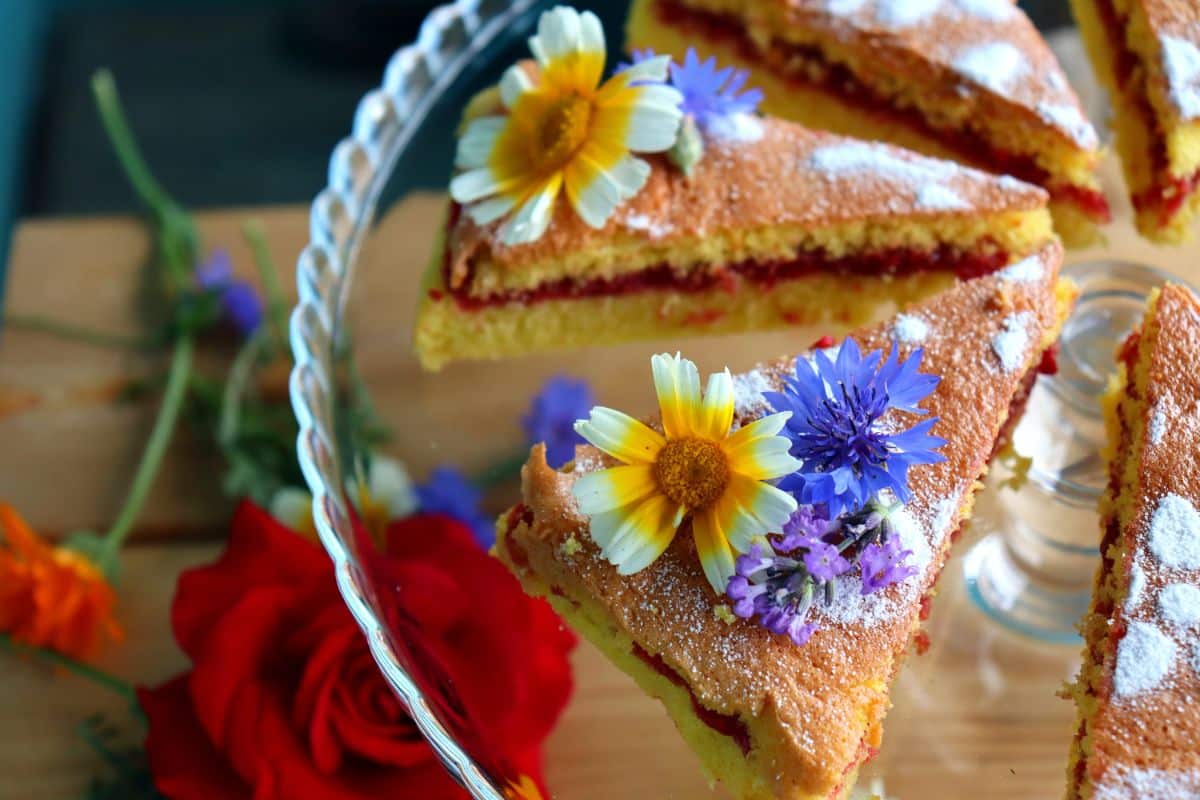
Jump to:
- 22 edible flowers to grow for creative salad toppers and garnishes
- 1. Borage (Borago officinalis)
- 2. Bachelor buttons (Centaurea cyanus)
- 3. Nasturtium (Tropaeolum majus)
- 4. Squash (Cucurbita spp.)
- 5. Violets (Viola sororia)
- 6. English Lavender (Lavandula angustifolia)
- 7. Calendula (Calendula officinalis)
- 8. Rose (Rosa spp.)
- 9. Thyme (Thymus vulgaris)
- 10. Radishes (Raphanus sativus)
- 11. Mint (Mentha spp.)
- 12. Chamomile (Chamaemelum nobile or Matricaria chamomilla)
- 13. Arugula (Eruca sativa)
- 14. Pineapple sage (Salvia elegans)
- 15. Lovage (Levisticum officinale)
- 16. Pansies (Viola × wittrockiana)
- 17. Dandelions (Taraxacum offinale)
- 18. Hibiscus (Hibiscus spp.)
- 19. Marigolds (Tagetes spp.)
- 20. Daylilies (Hemerocallis spp.)
- 21. Red clover (Trifolium pratense)
- 22. Sunflowers (Helianthus annus)
- Frequently asked questions
- Summary
22 edible flowers to grow for creative salad toppers and garnishes
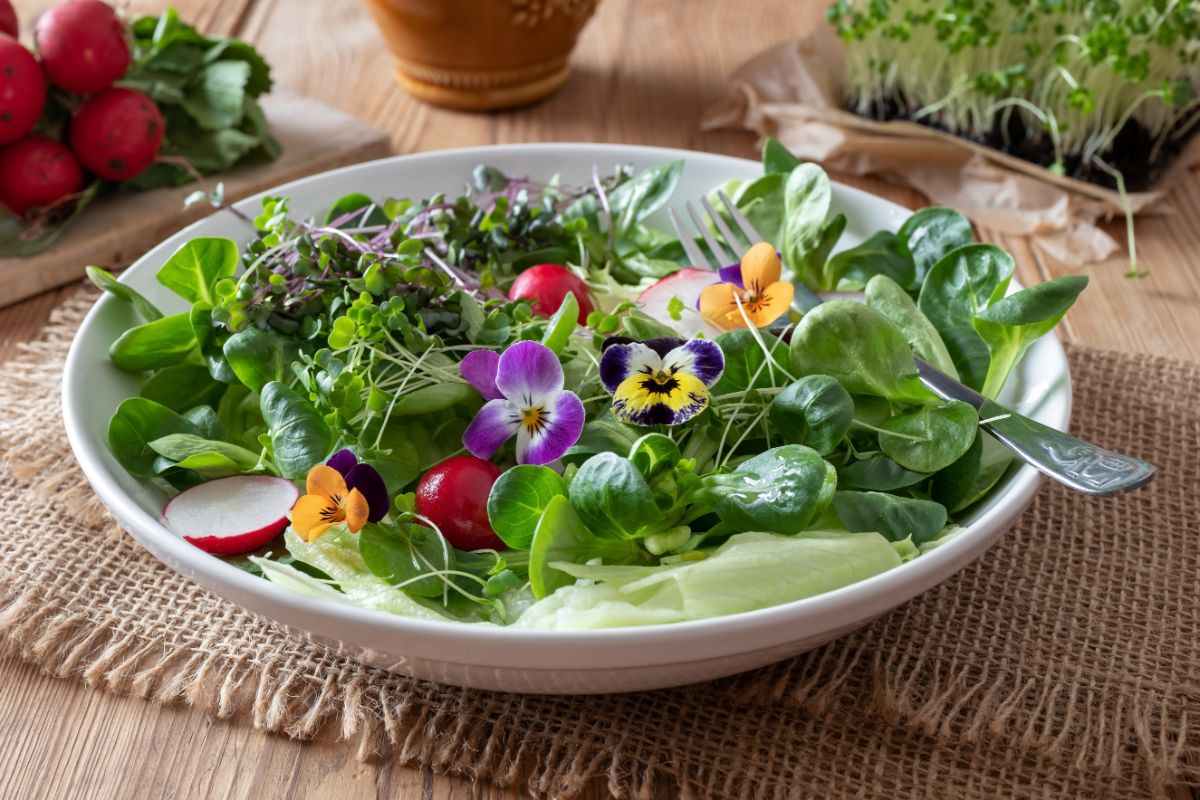
Edible flowers can be baked into cookies, steeped into teas, or sprinkled on top of dishes to add extra elegance and interest. Below you’ll find the most popular and easy-to-grow edible flowers, as well as suggestions on how to use them!
1. Borage (Borago officinalis)
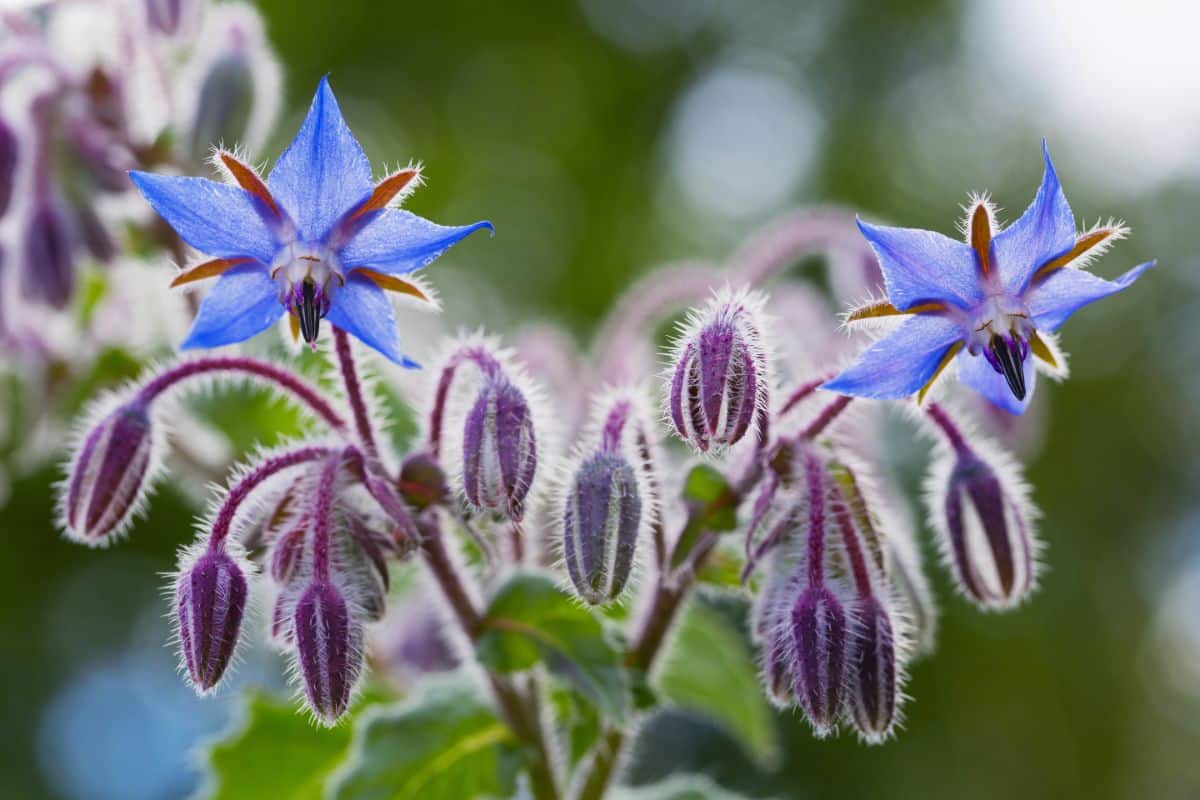
| Plant name: | Borage |
| Light requirements: | Full sun to part shade |
| Water requirements: | Moderate |
| Most common planting method: | Seed |
| Growing zone: | Zones 3 to 10 |
Undemanding yet colorful, borage is often included in edible flower seed mixes, although you can purchase borage seeds on their own as well. These star-shaped flowers have a brilliant, periwinkle blue coloration that’s sure to stand out in fresh salads and other dishes. You can also freeze borage blooms in ice cubes and serve them in a refreshing drink at your next garden party!
Borages are often overlooked plants, but they have a lot of uses in the kitchen and garden too. Borage leaves are edible, and they have a light, cucumber-like flavor that’s quite unique. Borage plants are also a top companion plant for repelling tomato hornworms, and their flowers attract pollinators too!
2. Bachelor buttons (Centaurea cyanus)
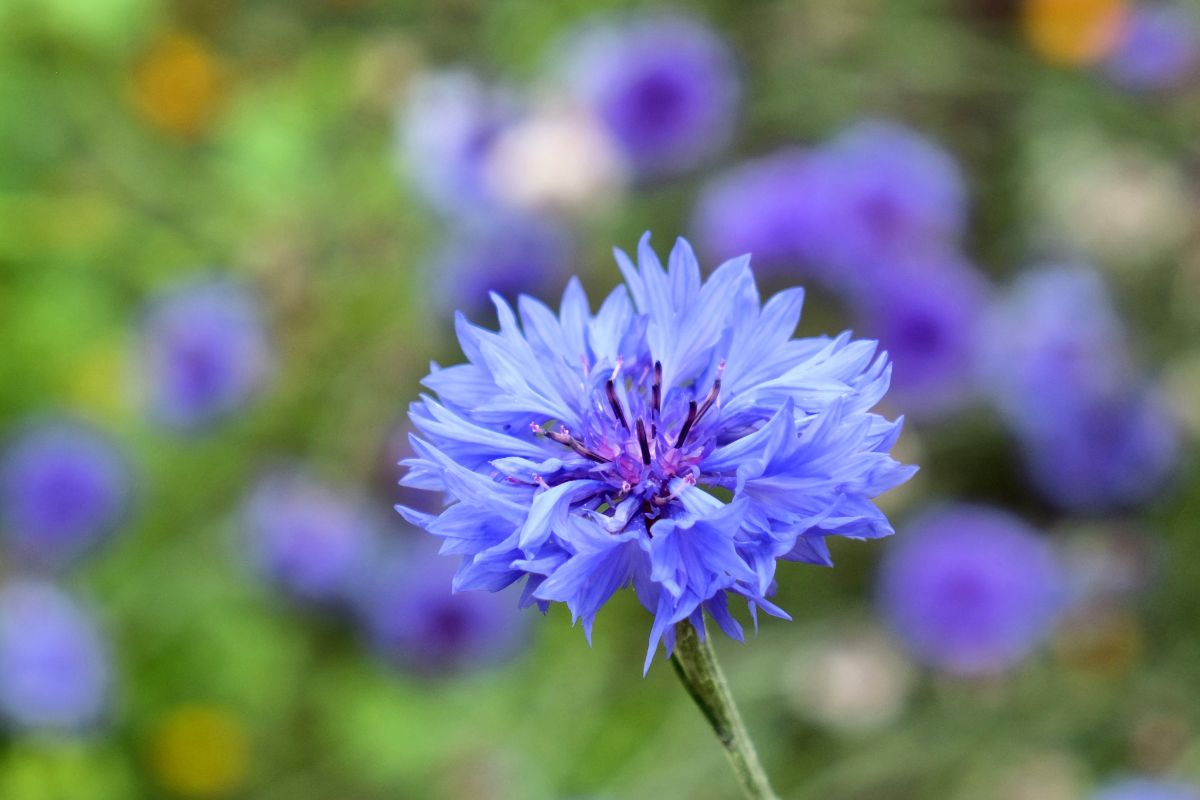
| Plant name: | Bachelor buttons |
| Light requirements: | Full sun |
| Water requirements: | Moderate |
| Most common planting method: | Seed |
| Growing zone: | Zones 2 to 11 |
Also known as cornflowers, bachelor buttons are famous for their bright blue flowers that have inspired paint colors, crayon hues, and other products too! But while bachelor buttons are mostly grown as ornamentals, their flowers are edible, and they add lots of saturated color to salads and other summer fares. Bachelor buttons can also be brewed into herbal teas, and they’re even useful for homemade textile dyes!
While bachelor buttons are native to Europe, they’re easy to grow elsewhere, and they sprout readily from seed. Just keep in mind that these plants are true annuals, and they will need to be planted every year unless you let your plants go to seed.
3. Nasturtium (Tropaeolum majus)
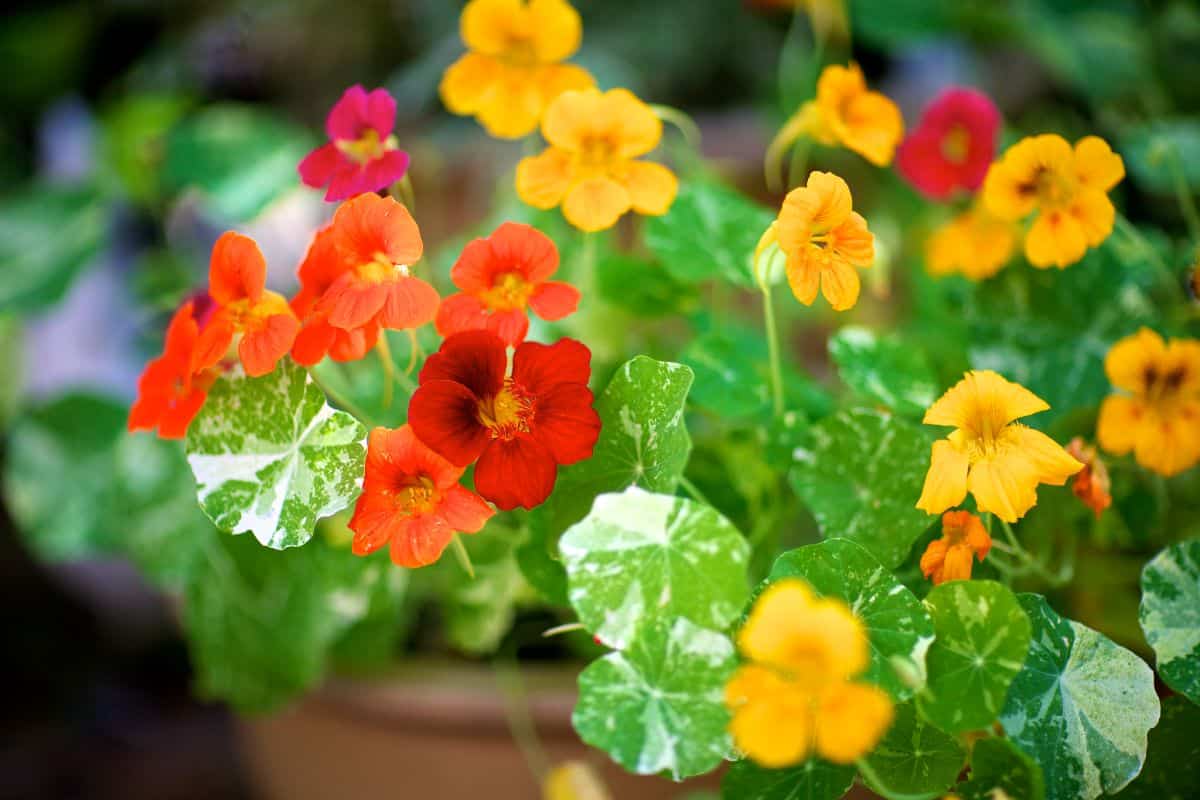
| Plant name: | Nasturtium |
| Light requirements: | Full sun |
| Water requirements: | Moderate |
| Most common planting method: | Seed |
| Growing zone: | Zones 9 to 11, grows as an annual in cooler areas |
Nasturtiums are often grown as salad greens or ornamental plants, but their vivid, orange-to-yellow flowers are also edible! Easy to grow from seed, nasturtiums come in both mounding and trailing forms. Mounding-type plants tend to be best for small spaces and container gardens while trailing nasturtiums can be trained to climb up trellising or drape over garden walls.
Beyond their beauty, nasturtium plants have a strong scent that can repel certain insects and attract others. So it’s no surprise that nasturtiums are one of the best companion plants you can grow for natural pest control and to boost pollinator activity in vegetable gardens. And don’t forget, nasturtium seeds can also be pickled and served like capers!
4. Squash (Cucurbita spp.)
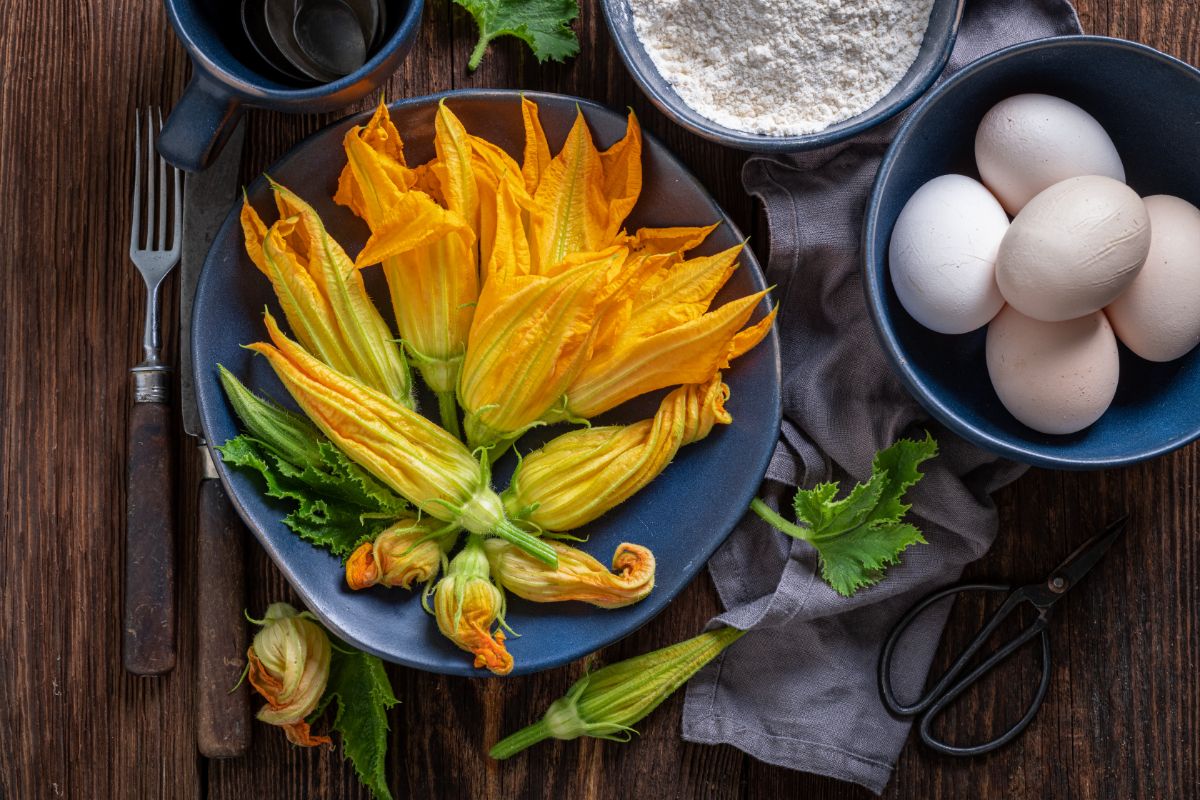
| Plant name: | Squash |
| Light requirements: | Full sun |
| Water requirements: | Moderate |
| Most common planting method: | Seed |
| Growing zone: | Zones 3 to 10 |
Probably the most famous edible flower around, squash or zucchini blossoms are commonly stuffed with ricotta cheese and fried to make a delicious and savory appetizer. But you can also serve squash blossoms in many different ways, and they can even be plated up raw in salads or as a garnish.
The recommended time to pick squash blossoms is in the early morning before the sun is high overhead. Squash plants produce both male and female flowers, and while both types are edible, it’s best to harvest male flowers because they don’t produce squash. Male flowers have thinner and hairier bases than female flowers, and they should be harvested before they open fully.
5. Violets (Viola sororia)
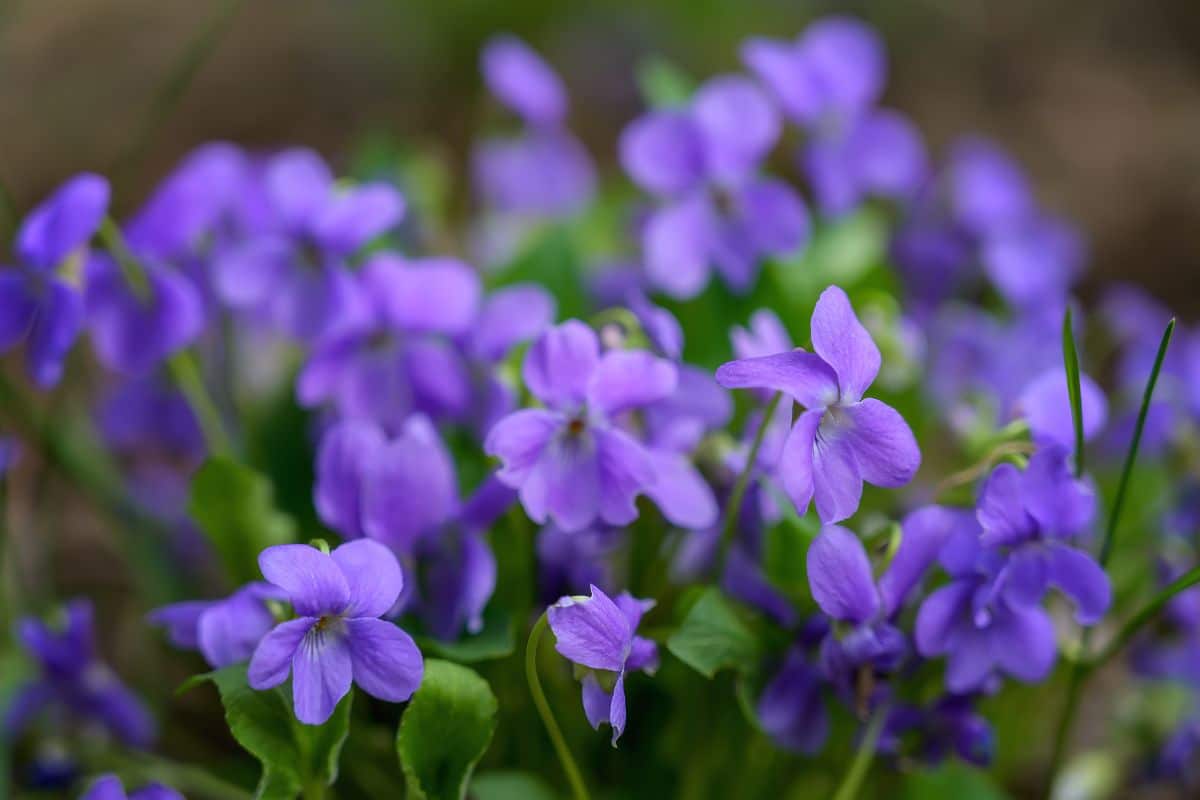
| Plant name: | Violets |
| Light requirements: | Full sun to part shade |
| Water requirements: | Moderate |
| Most common planting method: | Seed; Also commonly foraged |
| Growing zone: | Zones 3 to 9 |
All wild violets are edible, but most foragers argue that common blue violets have the best flavor. Violets frequently grow wild in garden beds, and they’re often considered to be nuisance weeds. However, if you’re looking for edible flowers to use in dishes, violets have a charming form and bright coloration that’s hard to resist.
Common violets can produce either purple, blue, or white flowers that are small and delicate and have a slightly nutty flavor. If you harvest violets from the wild, make sure you pick them in areas that haven’t been sprayed with pesticides or herbicides. For even easier harvesting, you can also grow wild violets intentionally in edible gardens and always have them on hand for salad making and more!
6. English Lavender (Lavandula angustifolia)
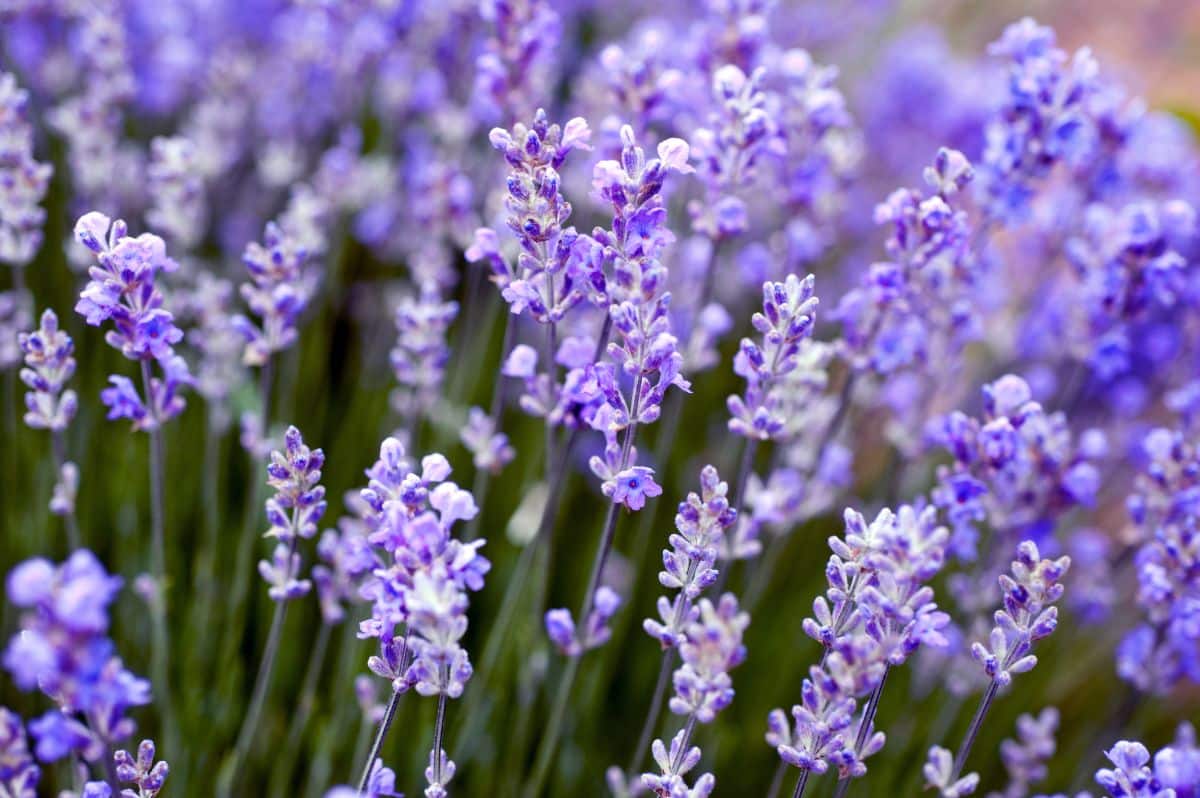
| Plant name: | English lavender |
| Light requirements: | Full sun |
| Water requirements: | Low |
| Most common planting method: | Nursery starts; Cuttings |
| Growing zone: | Zones 5 to 9 (most varieties) |
Lavender plants are often grown in fragrance gardens and ornamental beds, but if you’re on the hunt for edible plants, English lavender is the lavender variety you need to be looking for. Both the leaves and flowers of English lavender are edible, and they can be used as garnishes, herbal teas, or to flavor roasted meat or vegetable dishes. Even if you have a small garden space, you can still grow a lavender plant, or two since lavender is super easy to keep in containers.
Like other woody-stemmed herbs, English lavender doesn’t need much water, and it can be prone to root rot if it’s grown in soggy soil. To avoid this, make sure you keep lavender plants in a well-draining earth and provide them with plenty of bright sun. These plants will also benefit from annual pruning, which will prevent stems from getting leggy or woody.
7. Calendula (Calendula officinalis)
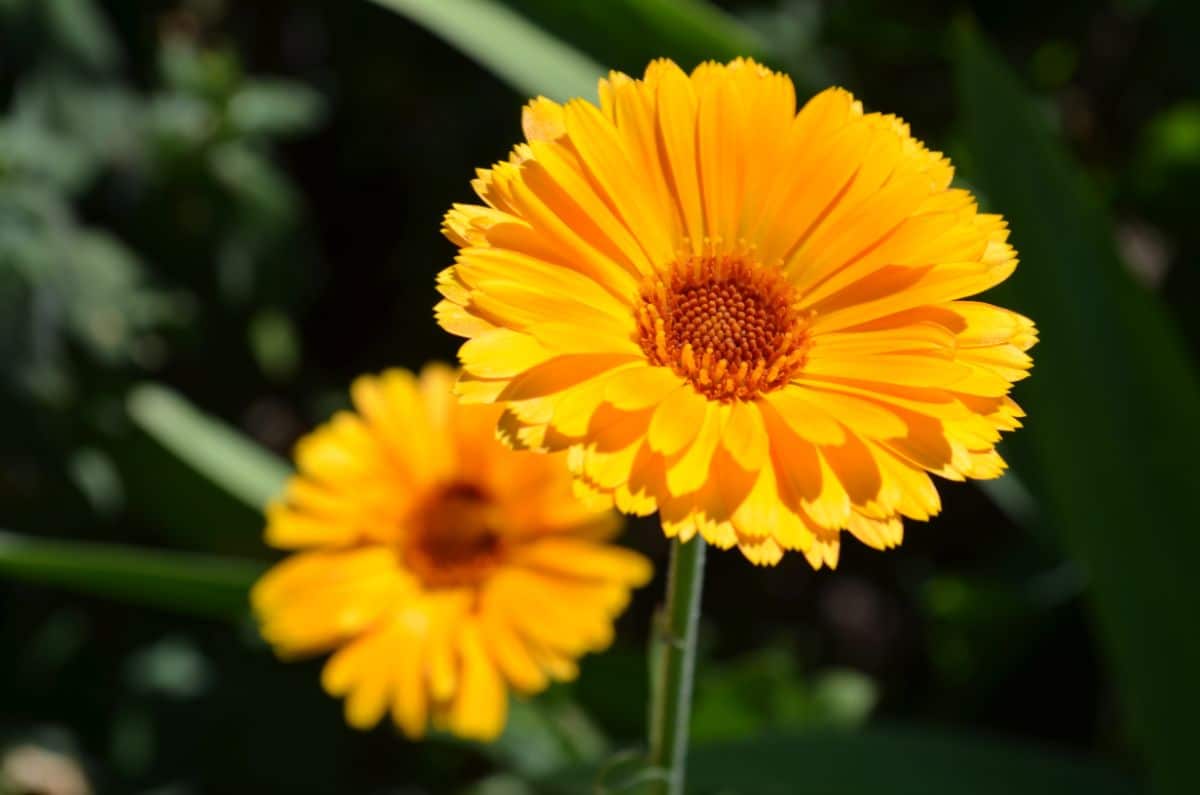
| Plant name: | Calendula |
| Light requirements: | Full sun to part shade |
| Water requirements: | Moderate |
| Most common planting method: | Seed |
| Growing zone: | Zones 9 to 11, grows as an annual in cooler areas |
Also known as pot marigolds, calendula is typically grown in medicinal herb gardens, but its daisy-like flowers make darling garnishes too. Like dandelions, calendula leaves are edible, but they have a bitter quality that may not be for everyone. Calendula blooms, on the other hand, have a much milder flavor, and they can be used fresh or baked into pastries and other sweet treats.
Calendula flowers commonly come in a vivid yellow to orange color, but you can also find white or bi-colored varieties. These plants are often sold at plant nurseries, but they also grow readily from seed. In warm areas, calendula can grow as a perennial, but it’s generally cultivated as an annual in growing zones 2 through 8.
8. Rose (Rosa spp.)
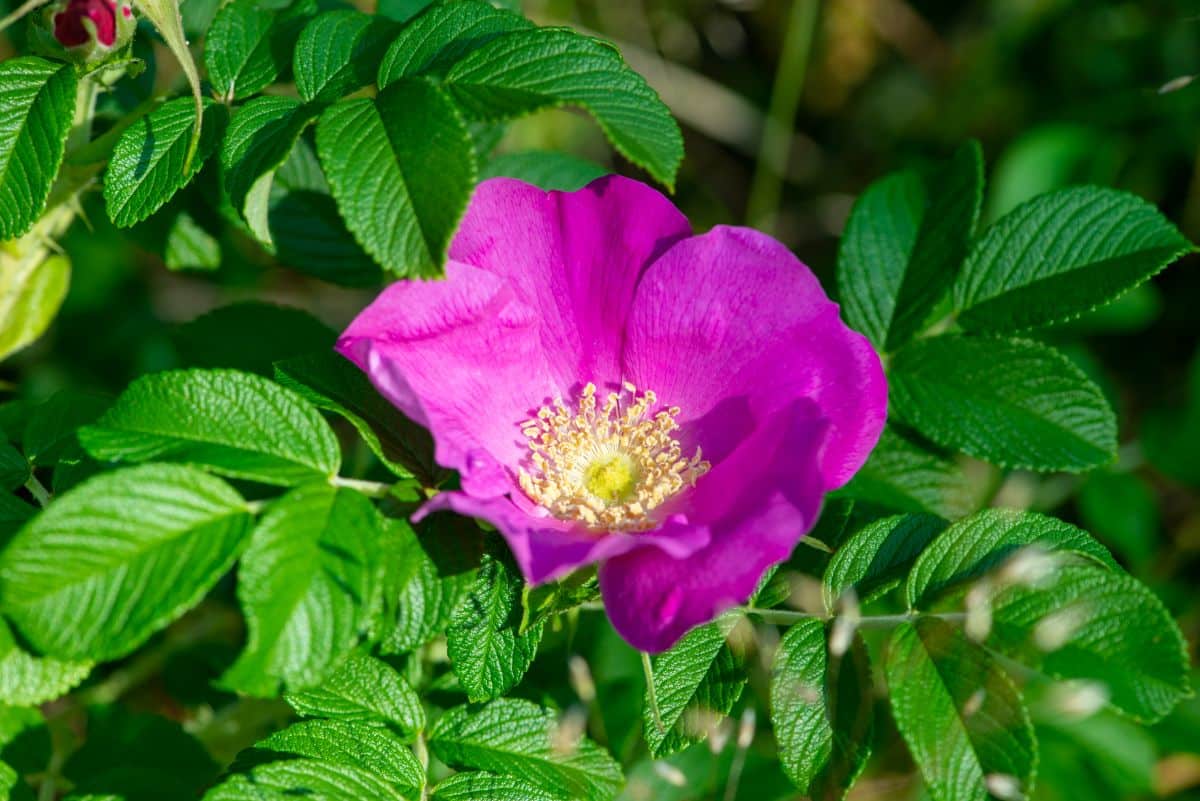
| Plant name: | Rose |
| Light requirements: | Full sun |
| Water requirements: | Moderate |
| Most common planting method: | Nursery starts |
| Growing zone: | Depends on variety |
Roses are mostly kept as ornamentals, but rosehips make a delicious tea or jelly, and rose petals are edible too. Packed with vitamin C and other antioxidants, rose petals come in many different colors and sizes, and they’re an easy way to spruce up dull salads and other dishes.
When using roses as edibles, make sure you harvest your petals from safe areas where plants haven’t been subjected to chemical pesticides or herbicide sprays. If you have roses already growing in your garden, try out companion planting, which can keep pests away all-naturally!
9. Thyme (Thymus vulgaris)
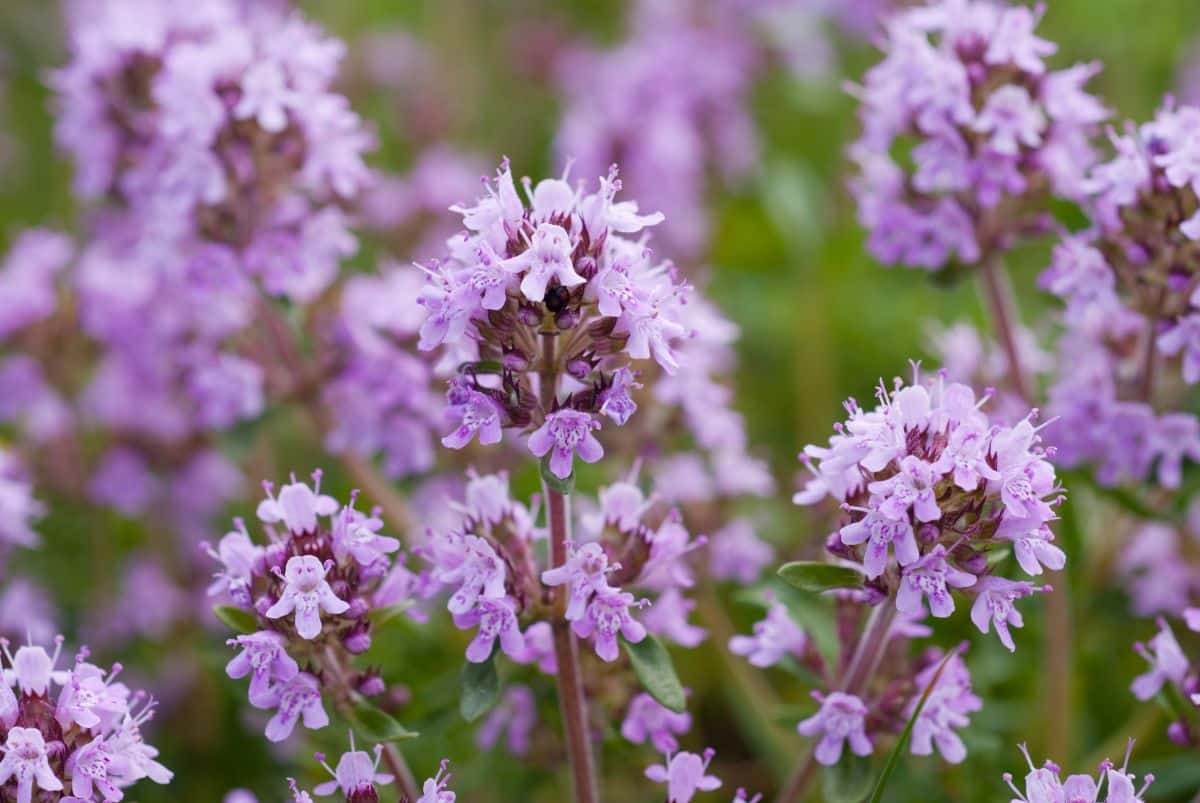
| Plant name: | Thyme |
| Light requirements: | Full sun |
| Water requirements: | Low |
| Most common planting method: | Nursery starts; Cuttings |
| Growing zone: | Zones 5 to 9 |
All varieties of thyme are edible, but common thyme is the type that’s typically grown for culinary purposes. This easy-going herb thrives in drier gardens, and it’s quite a cold hardy too. Plus, common thyme blooms prolifically in spring and summer with darling pink, white, or red flowers that make the perfect garnishes.
Depending on the size of your garden, thyme can be grown in inground beds or small pots. This plant will also grow happily when planted with other woody-stemmed herbs, like rosemary and lavender. If you want even more colorful plants, try out thyme varieties with variegated leaves!
10. Radishes (Raphanus sativus)
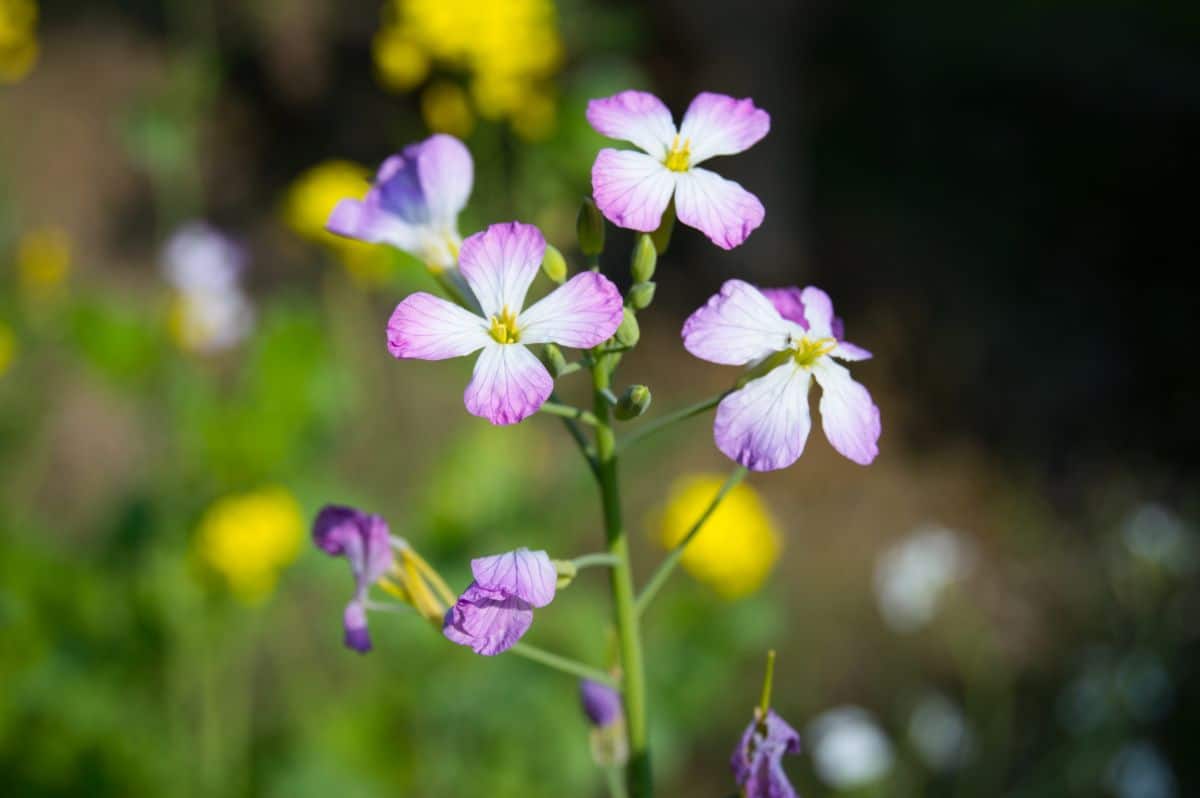
| Plant name: | Radishes |
| Light requirements: | Full sun |
| Water requirements: | Moderate |
| Most common planting method: | Seed |
| Growing zone: | Zones 2 to 11 |
Radishes are mostly grown for their edible roots, but if you don’t harvest radishes in time, they also produce dainty white, pink, or purple flowers that can be used as garnishes or flavoring elements! Radish blooms are usually happy accidents in the garden, and unfortunately, by the time they appear, the radish roots are too woody to eat. For this reason, you may want to plant some radish seeds for roots and additional seeds for flowers!
Almost all radish varieties will eventually flower, but you can get radish blooms earlier if you keep fast-growing radish types, like ‘Easter Egg’ radishes. Flowers are also more likely to sprout in summer-grown radishes as flowering occurs when radishes bolt in the heat.
11. Mint (Mentha spp.)
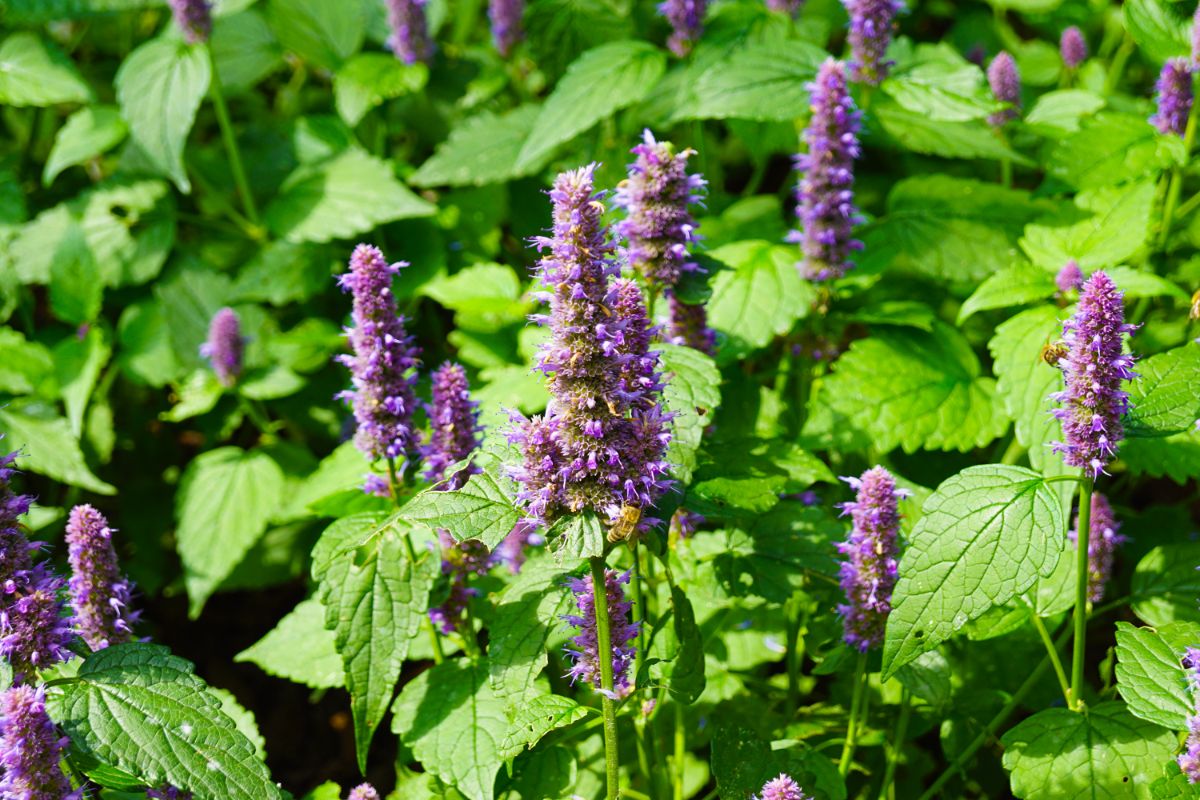
| Plant name: | Mint |
| Light requirements: | Full sun to part shade |
| Water requirements: | Moderate |
| Most common planting method: | Nursery starts; Cuttings |
| Growing zone: | Zones 3 to 10 |
Mint is a perennial herb that flowers small, pink, purple, or white blooms throughout the warmer months. With a long bloom time and an undemanding nature, mint blossoms are some of the easiest edible flowers to grow. Plus, if you grow mint for flowers, you’ll also end up with loads of fresh mint for desserts, teas, and other dishes.
Beyond being edible, mint flowers are highly attractive to bees and other pollinators, and growing mint near your vegetables is a solid way to boost pollination rates. However, since mint is a vigorous spreader, you’ll want to be wary about planting mint directly in your garden. Instead, try growing mint in pots placed throughout your landscape, which will give you all the benefits of mint, but it will also keep mint plants from taking over!
12. Chamomile (Chamaemelum nobile or Matricaria chamomilla)
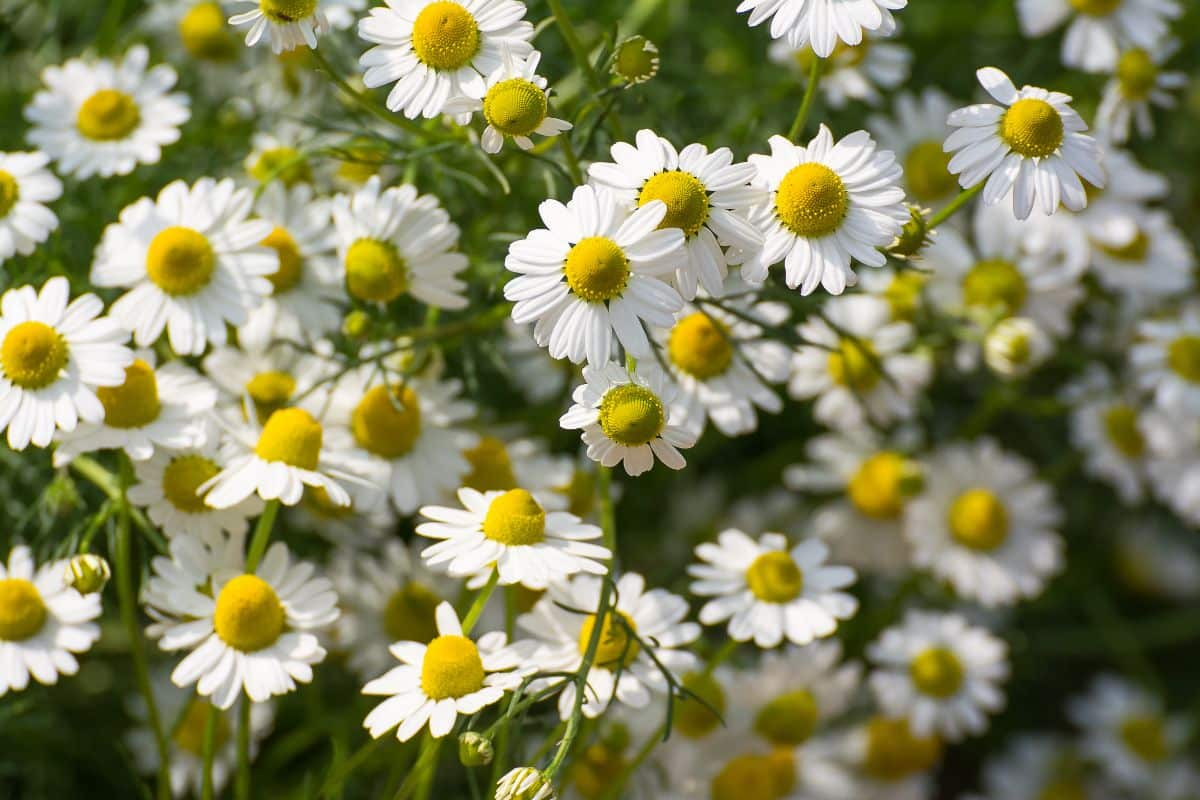
| Plant name: | Chamomile |
| Light requirements: | Full sun to part shade |
| Water requirements: | Moderate to low |
| Most common planting method: | Seed |
| Growing zone: | Depends on variety |
Both Roman and German chamomile plants can be grown in gardens for their edible flowers; however, they have slightly different growing needs. Roman chamomile is an annual plant that’s often used as a low-growing groundcover. German chamomile, on the other hand, is a taller species, and it only grows as an annual.
Chamomile is mostly known as an ingredient in herbal teas, but the flowers can also be cooked into jellies, baked into desserts, or used as colorful garnishes. These plants have a distinct floral fragrance and flavor, and their daisy-like blooms are cute as buttons too!
13. Arugula (Eruca sativa)
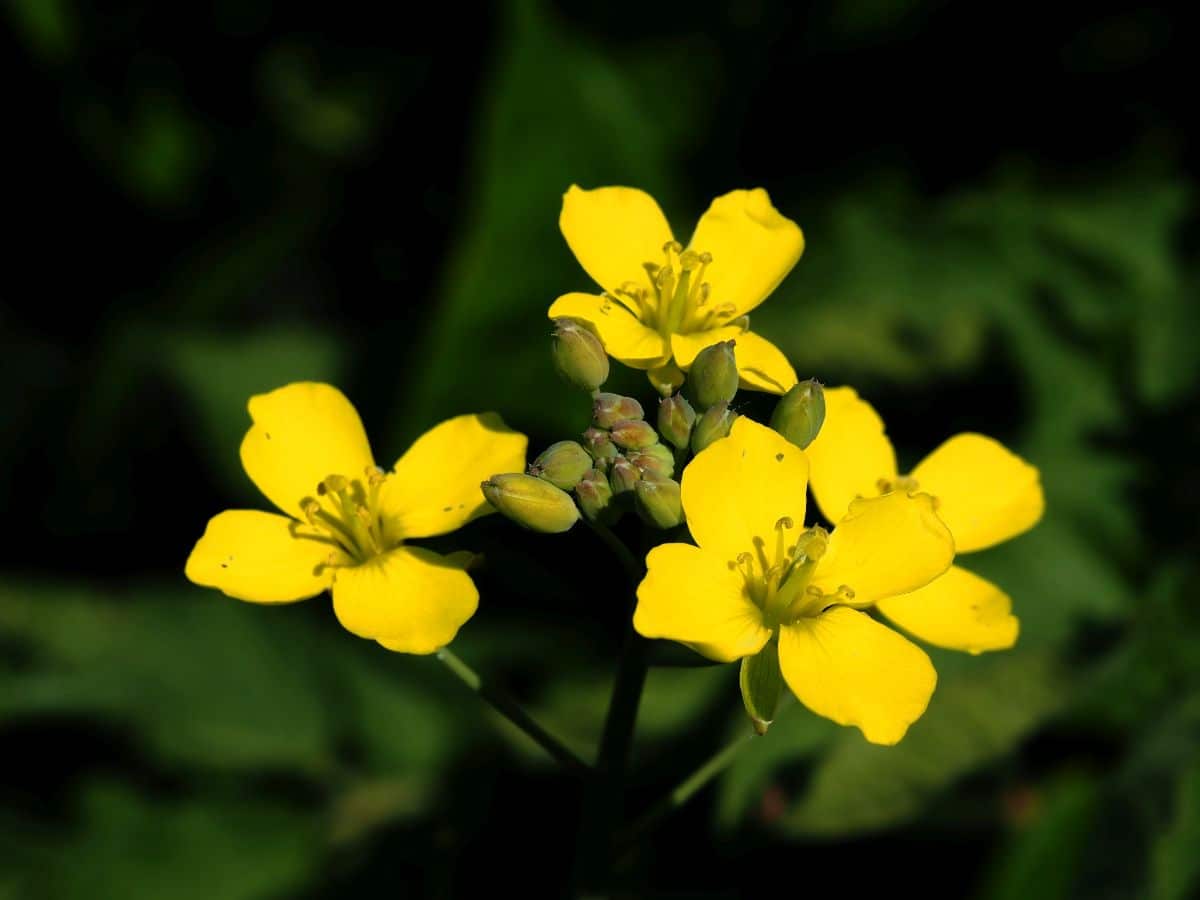
| Plant name: | Arugula |
| Light requirements: | Full sun |
| Water requirements: | Moderate |
| Most common planting method: | Seed |
| Growing zone: | Zones 3 to 11 |
Like radishes, arugula flowers are often an unintentional “bonus” that develops after the plant begins to bolt. But arugula flowers are just as tasty as the plant’s leaves, and they offer an intriguing, peppery flavor to any dish they’re mixed into.
Arugula is generally kept as a cool-weather, spring salad green, but if you want to harvest the plant’s edible flowers, you can continue to sow arugula seeds in the warmer months too. Cold hardy arugula can also be grown in fall and winter. However, in cooler climates, you may want to install grow tunnels or cloches over your plants to protect them from snow and inclement weather.
14. Pineapple sage (Salvia elegans)
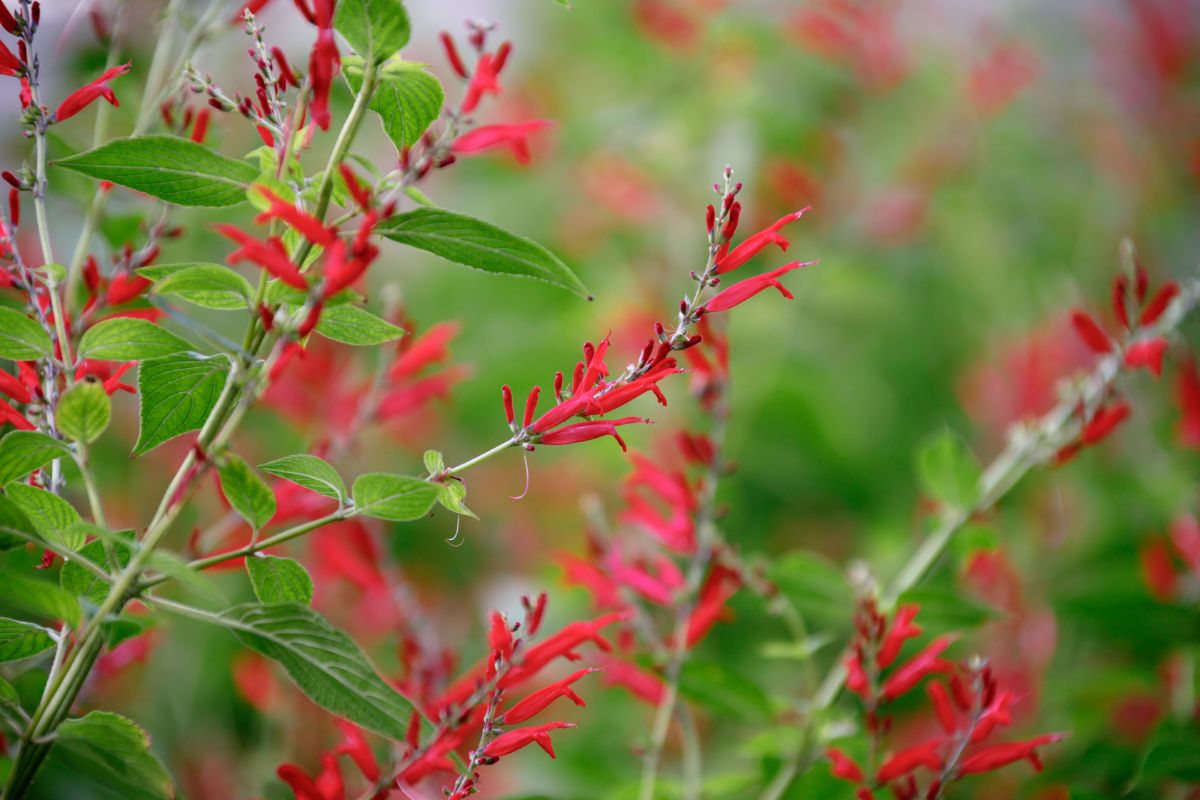
| Plant name: | Pineapple sage |
| Light requirements: | Full sun |
| Water requirements: | Moderate to low |
| Most common planting method: | Nursery starts; Cuttings |
| Growing zone: | Zones 8 to 11 |
Pineapple sage is a colorful herb that isn’t as commonly grown, but that doesn’t make it any less spectacular! This plant is a variety of salvia that’s native to Mexico, but it can be grown as an annual in cool climates. Both the leaves and flowers of pineapple sage are edible, and they have a bright, fruity flavor with notes of mint.
Pineapple sage is named for the citrusy aroma the leaves produce when they’re crushed between your fingers. But while this plant is famous for its scent, it’s also prized for its ability to attract pollinators. Pineapple sage’s cardinal red flowers are always a hit, with hummingbirds and butterflies loving them too!
15. Lovage (Levisticum officinale)
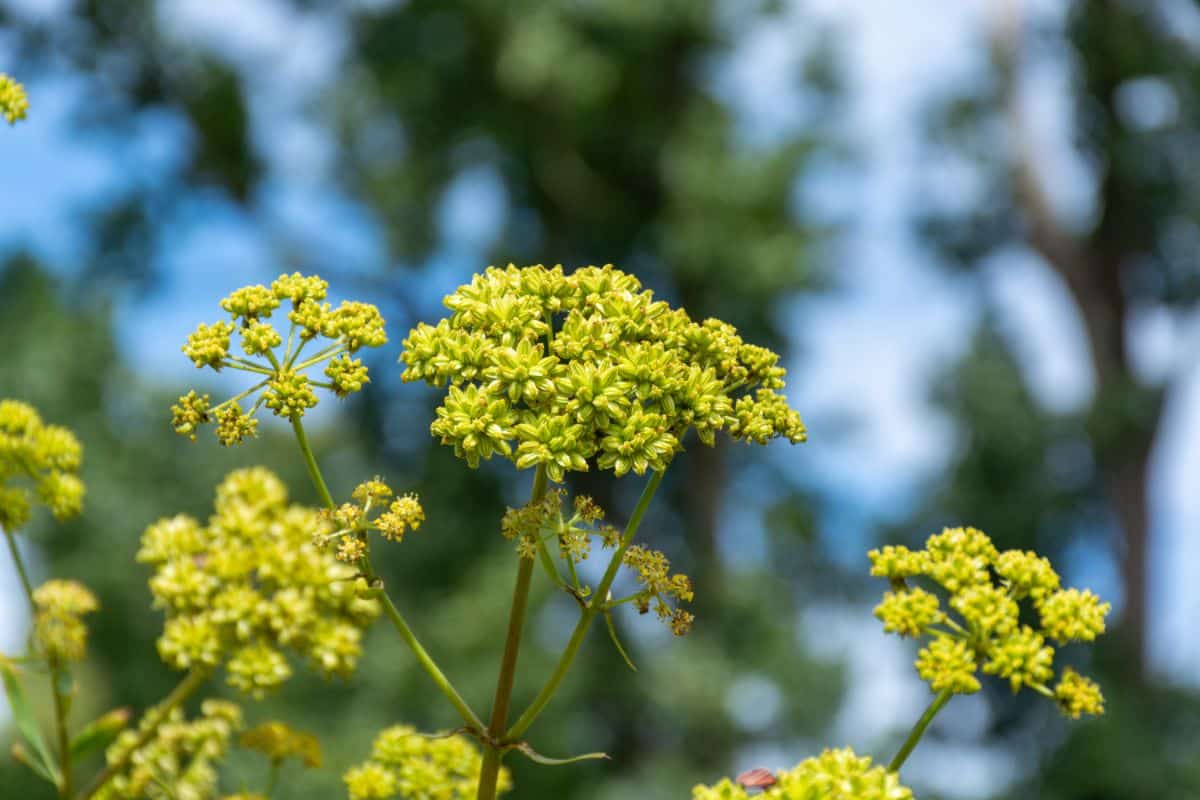
| Plant name: | Lovage |
| Light requirements: | Full sun to part shade |
| Water requirements: | Moderate |
| Most common planting method: | Nursery starts |
| Growing zone: | Zones 3 to 9 |
Lovage is a bit of an old-fashioned herb, but it’s making a comeback. This plant is a member of the Umbellifer family, and it’s closely related to carrots and parsley. Most people grow lovage for its leaves, which taste a lot like celery, but lovage also produces sprays of yellow flowers that are edible too!
Compared to celery, lovage is much easier to grow, so many gardeners grow lovage as a celery substitute. Lovage grows perennially in most areas, and it has incredible cold tolerance that allows it to overwinter in areas as cold as Zone 3. Lovage can also be grown in inground gardens or pots, but since mature plants can reach up to 6’ tall, you’ll want to locate them towards the back of your garden beds or in large containers.
16. Pansies (Viola × wittrockiana)
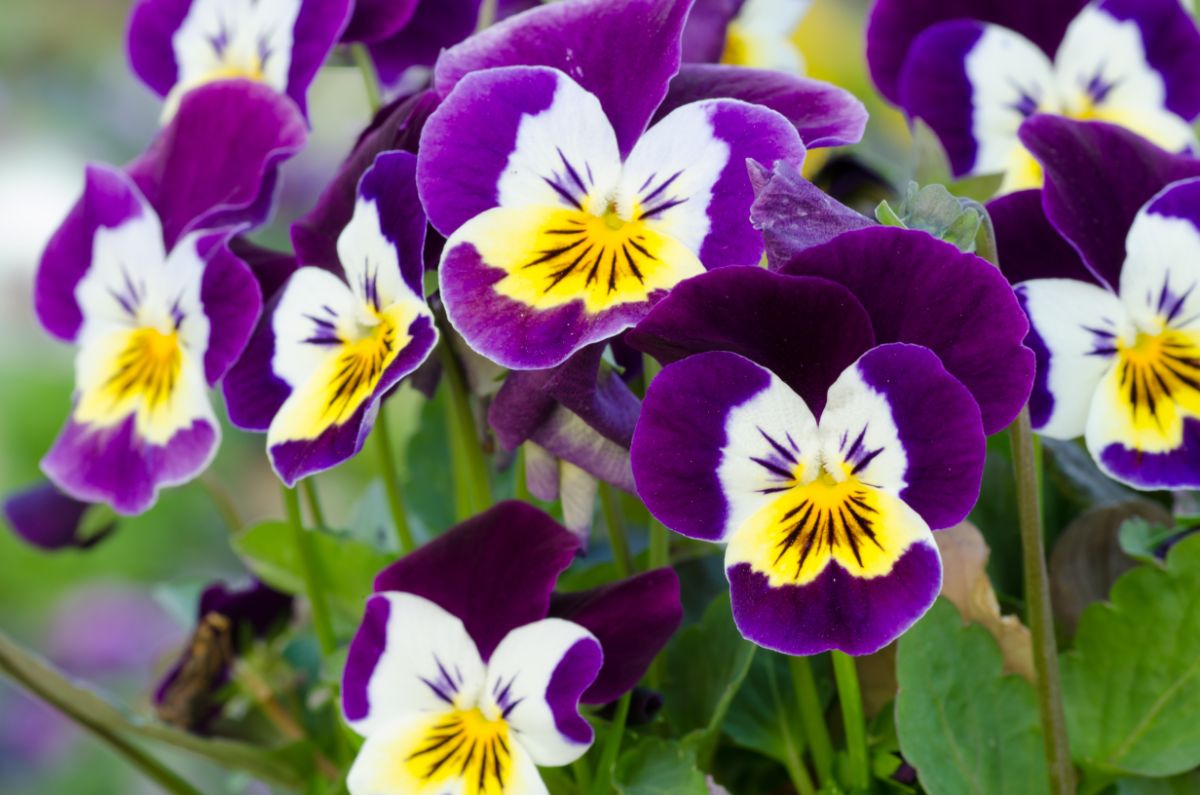
| Plant name: | Pansies |
| Light requirements: | Full sun to part shade |
| Water requirements: | Moderate |
| Most common planting method: | Nursery starts; Seed |
| Growing zone: | Zones 3 to 8 |
A close relative of violets, pansies, and violas are also edible, and they’re some of the most colorful salad toppers around. Despite their delicate look, pansies are surprisingly cold hardy, and they bloom in cool springs and frosty falls, although they may stop producing flowers during the summer heat.
Pansies are quite easy to find, and they’re often sold as ornamentals at big box stores, or you can grow them from seed. Keep pansies in inground gardens, hanging baskets, or containers -- these tough plants will thrive just about any place you sow them!
17. Dandelions (Taraxacum offinale)
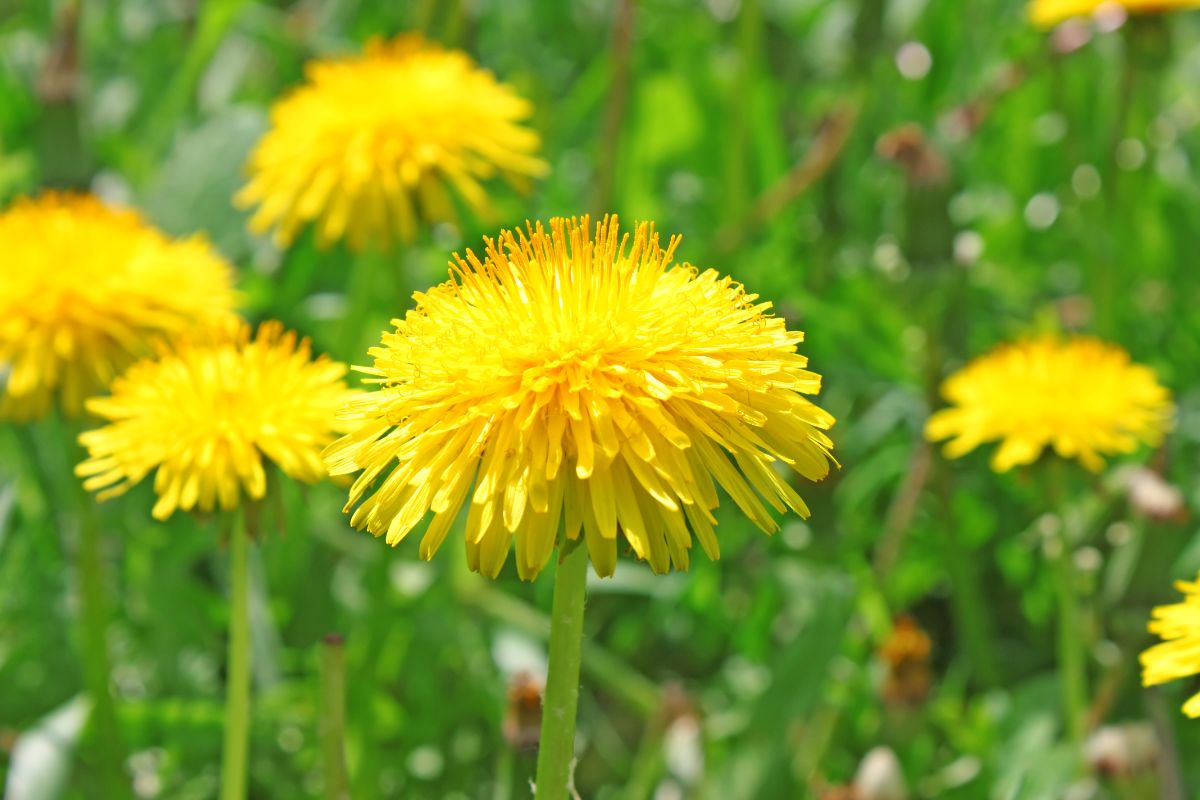
| Plant name: | Dandelions |
| Light requirements: | Full sun |
| Water requirements: | Moderate |
| Most common planting method: | Seed; Also commonly foraged |
| Growing zone: | Zones 3 to 9 |
Many people consider dandelions to be nuisance weeds, but they are some of the most nutritious plants you can find. All parts of dandelions are edible, including their leaves and roots. However, dandelion flowers are particularly appealing, and their sunny yellow color makes them perfect accent garnishes.
Dandelions may grow naturally in your garden, or you can forage them in the wild. However, if you pick dandelions in new areas, make sure you harvest them from locations that haven’t been sprayed with pesticides or herbicides. If you grow dandelions from seed, you can also try out pink dandelions, which are harder to find but absolutely stunning!
18. Hibiscus (Hibiscus spp.)
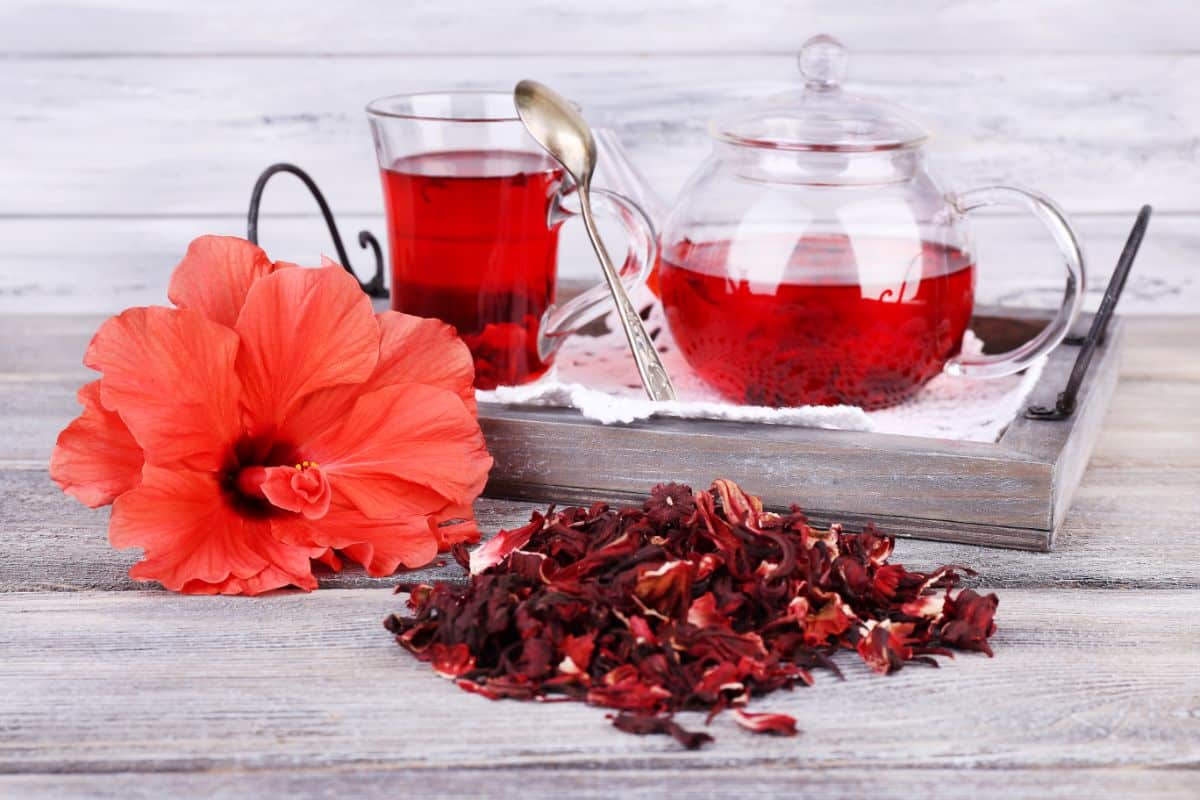
| Plant name: | Hibiscus |
| Light requirements: | Full sun to part shade |
| Water requirements: | Moderate |
| Most common planting method: | Nursery starts |
| Growing zone: | Depends on variety |
Hibiscus plants belong to the mallow family, and with hundreds of different species to choose from, home gardeners can find the perfect hibiscus varieties to their suit their garden space. Most hibiscus are grown solely as ornamentals, but there are a few edible varieties, including the Rose of Sharon (Hibiscus sinosyriacus) and the cranberry hibiscus (Hibiscus acetosella). Intriguingly, okra is also a member of the hibiscus family, and its flowers are edible too!
Hibiscus flowers can be used in desserts, jams, and jellies, but most commonly, flowers are brewed into hot and cold teas. Some hibiscus plants can get quite tall, but you can also find dwarf varieties that are just the right size for container gardens.
19. Marigolds (Tagetes spp.)
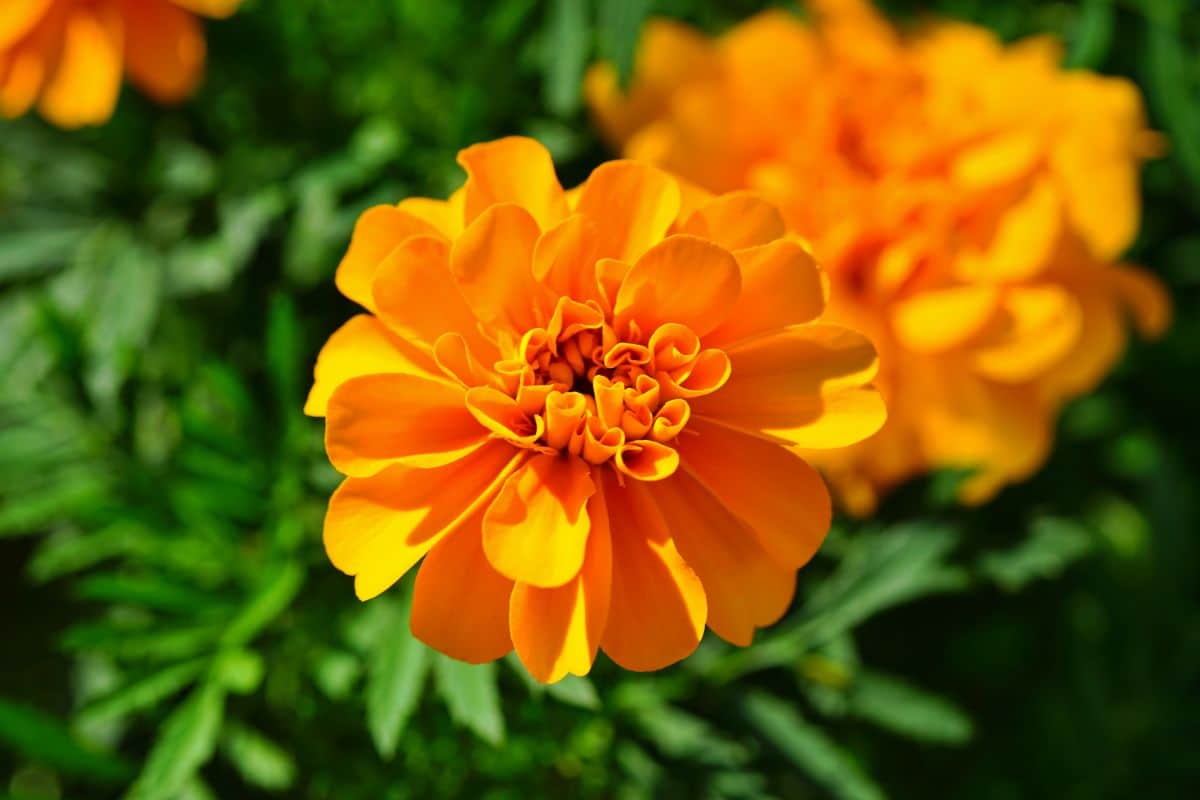
| Plant name: | Marigolds |
| Light requirements: | Full sun |
| Water requirements: | Moderate |
| Most common planting method: | Seed; Nursery starts |
| Growing zone: | Zones 2 to 11 |
Marigolds are well-known for their bright flowers that come in various shades of red, orange, and yellow. However, many gardeners don’t realize that the leaves and flowers of marigolds are edible and they can be used in both sweet and savory dishes.
Most commonly, marigolds are grown as ornamentals, but they’re also exceptional companion plants for most vegetables. Marigolds are adept at attracting beneficial insects, which can increase vegetable pollination rates and keep pests away too. Even better, marigolds are super adaptable and cold hardy plants that can be grown in inground gardens, hanging baskets, or pots – you name it!
20. Daylilies (Hemerocallis spp.)
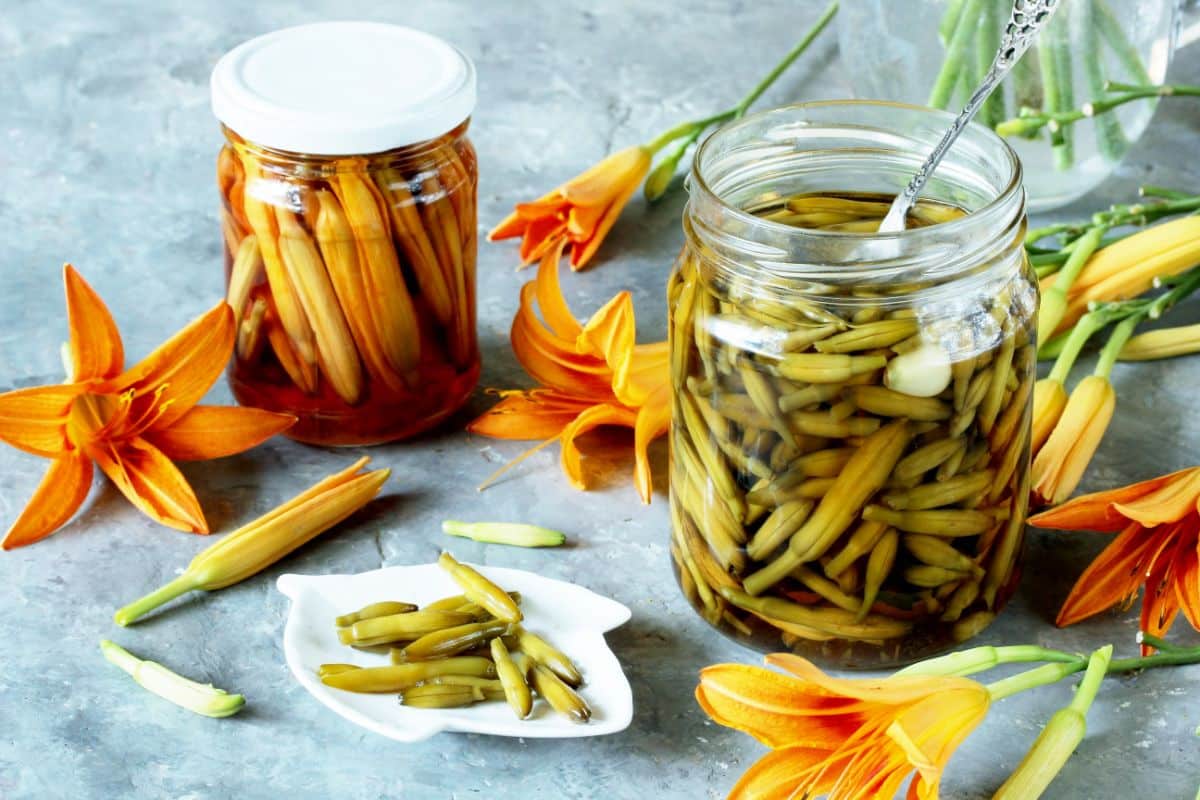
| Plant name: | Daylilies |
| Light requirements: | Full sun to part shade |
| Water requirements: | Moderate |
| Most common planting method: | Nursery starts; Plant division |
| Growing zone: | Zones 2 to 11 |
Despite their name, daylilies are not true lilies, and they actually belong to an entirely different plant family. Native to Asia, daylilies were first introduced to the United States in the 18th century, and they’ve been a popular landscaping plant ever since. However, daylilies are also entirely edible, and their young buds and petals make delightful culinary accents.
While most edible plants are primarily used as garnishes, daylilies are so tasty that many growers actually cultivate them deliberately as food crops. Daylily blooms can be used both fresh and dried, and they have a deep, vegetal flavor that’s somewhere between asparagus and garden peas!
21. Red clover (Trifolium pratense)

| Plant name: | Red clover |
| Light requirements: | Full sun to part shade |
| Water requirements: | Moderate to low |
| Most common planting method: | Seed; Also commonly foraged |
| Growing zone: | Zones 4 and up |
Like dandelions, red clover is often considered to be a weed, but it also makes an eco-friendly grass alternative, and its showy, pinkish-purple blooms are pretty enough for herb gardens too. Red clover is a springtime bloomer, but it often continues to flower throughout summer. When red clover is in bloom, bees are always nearby because pollinators adore red clover!
Red clover is generally used in teas and preserves, but the flower petals can also be steeped into cocktails, baked into pastries, or used in other creative ways. As with dandelions, make sure you harvest red clover from herbicide-free areas and always leave a few blooms behind for the bees!
22. Sunflowers (Helianthus annus)
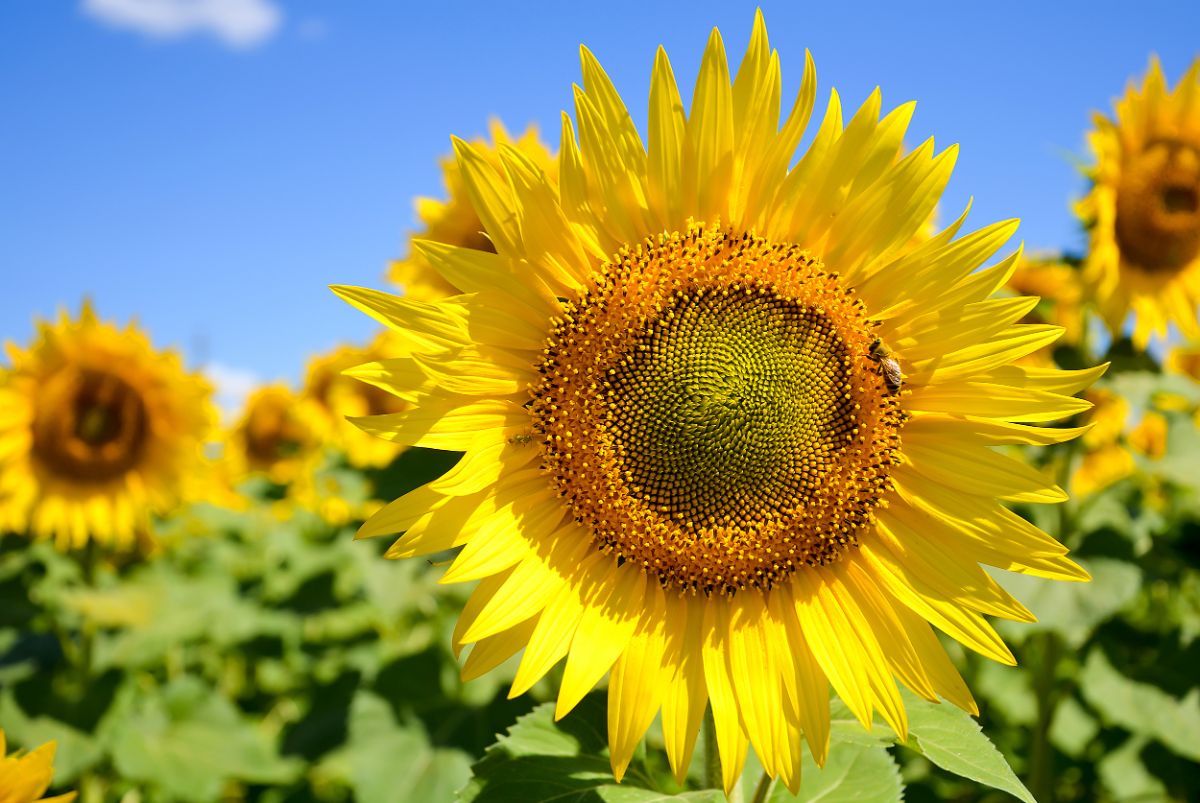
| Plant name: | Sunflowers |
| Light requirements: | Full sun |
| Water requirements: | Moderate |
| Most common planting method: | Seed |
| Growing zone: | Zones 4 to 9 |
Sunflowers are the mascots of summer, with petals bright as sunshine and wide open flower face that are ideal for bouquet-making. But sunflowers are also edible, and both their petals and seeds make tasty garden treats. Whole sunflower heads can be grilled on backyard barbecues, but you’ll want to harvest them before their seeds harden to get the best flavor and texture.
Today, there are countless varieties of sunflowers to choose from, including mammoth sunflowers that grow up to 17’ tall and dwarf varieties that are perfect for pots. You can also find sunflowers with many different flower colors, including golden yellow, maroon, and chocolate brown.
Frequently asked questions
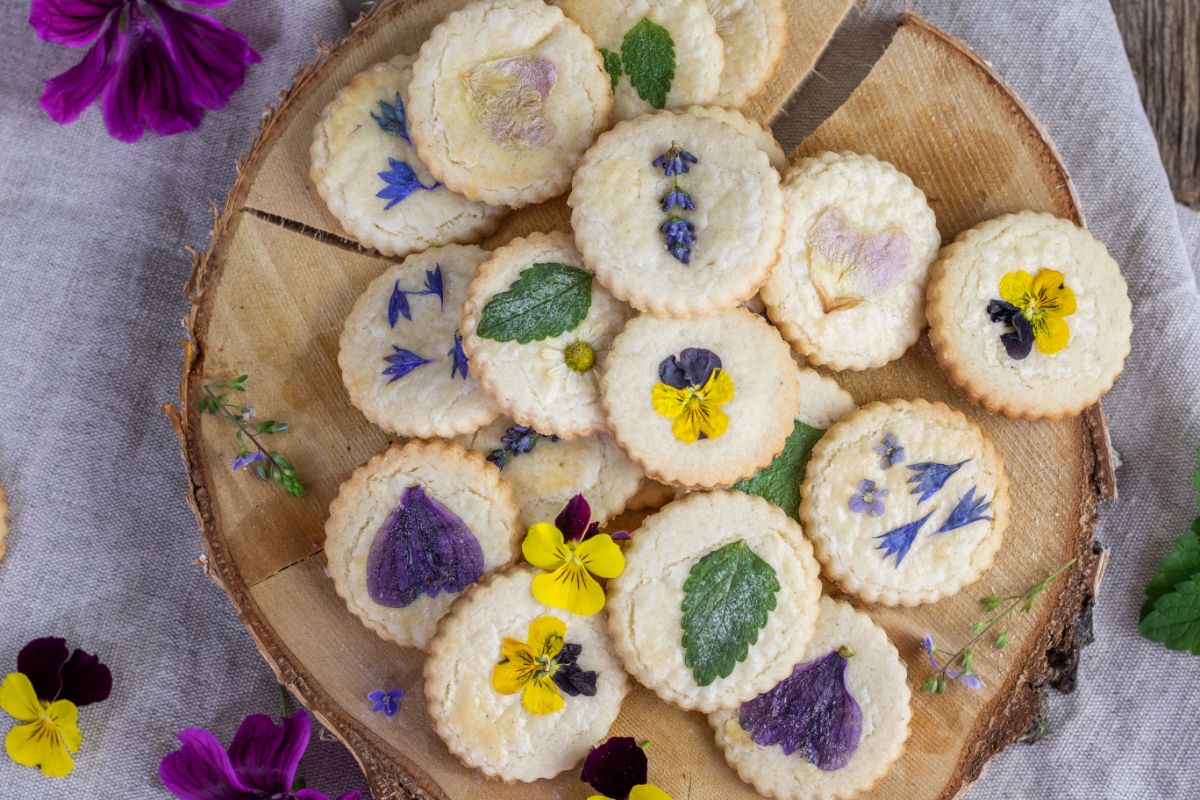
Saffron crocus is the most expensive edible flower, and a single ounce of saffron can cost hundreds of dollars!
Broccoli! While most people don’t consider broccoli a flower, broccoli crowns are actually the immature flowers of broccoli plants.
Most edible flowers have a refreshing, vegetal flavor, or they taste quite mild; however, honeysuckle is known for its sweet taste. In fact, honeysuckle’s sugary sweet nectar is how the plant got its name!
Summary
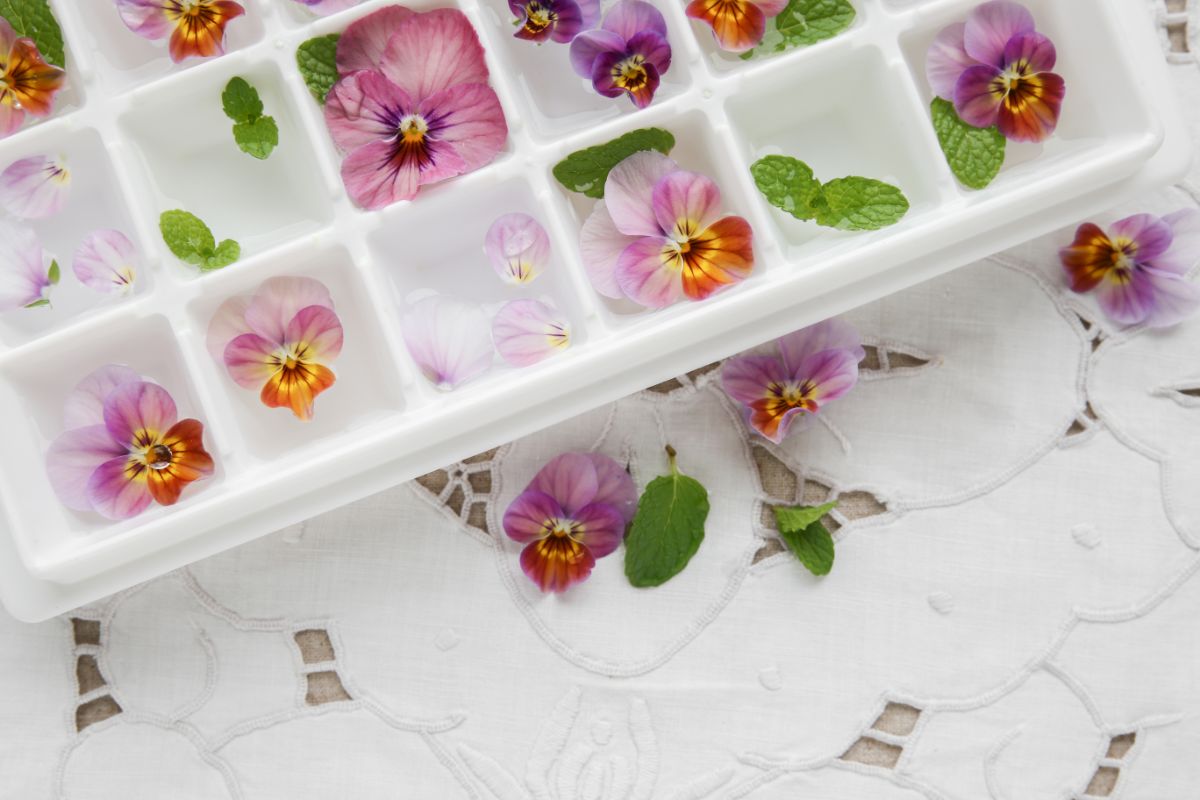
Thanks to their small size and versatility, most edible flowers can be grown in container gardens or inground beds. Slip these plants in among your veggies, or even grow them in a hanging basket on a sunny back porch. No matter what edible flower you choose to grow, these elegant garnishes will take any recipe to the next level.
Although edible flowers can be cultivated intentionally, many edible flowers also grow as “weeds” in our backyards. Check out our guide on edible weeds to forage in your garden and gather some of these edible blooms for free!

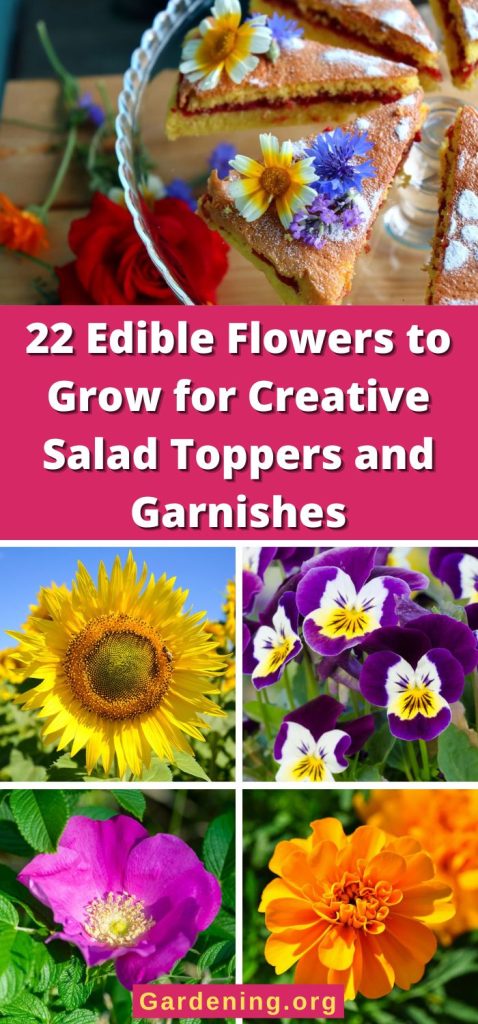

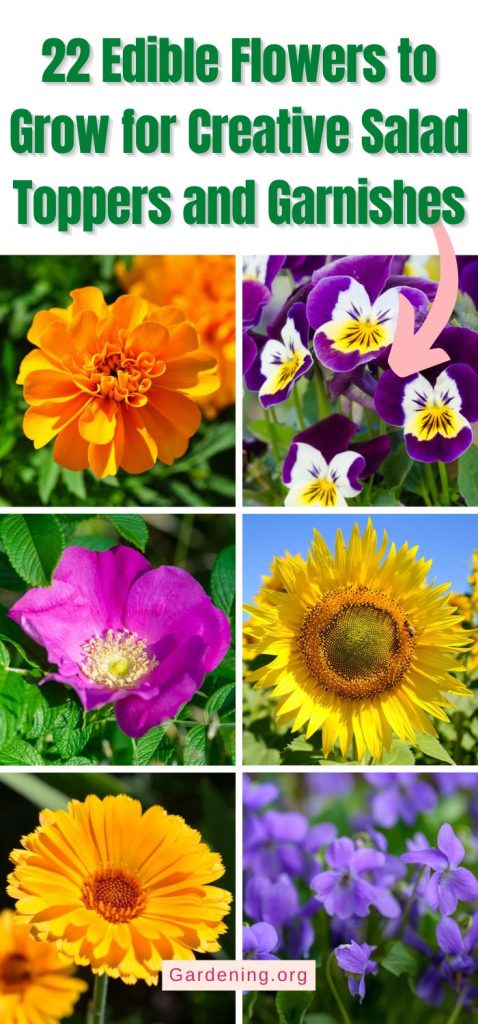


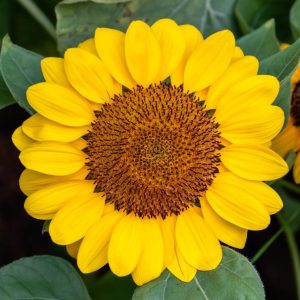
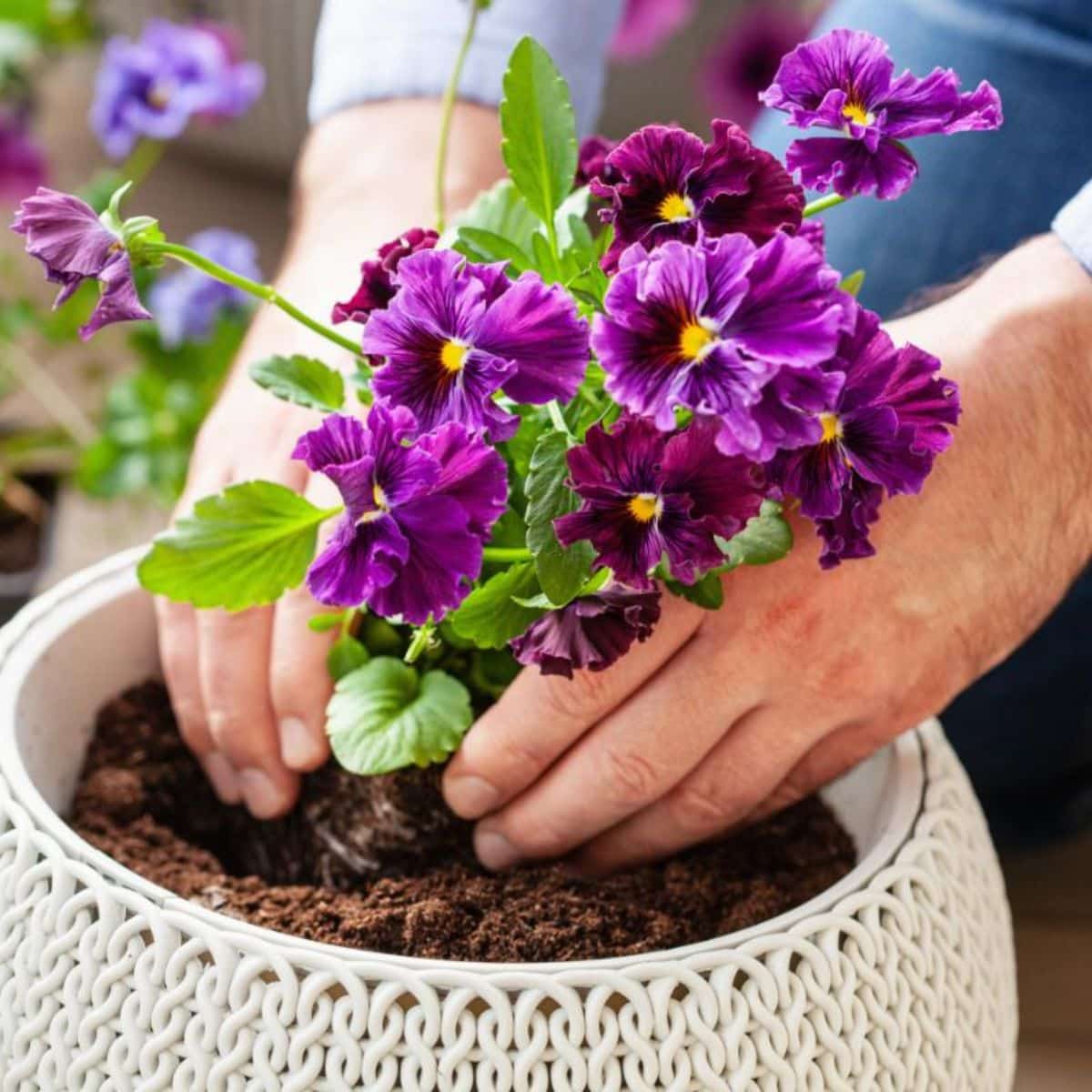
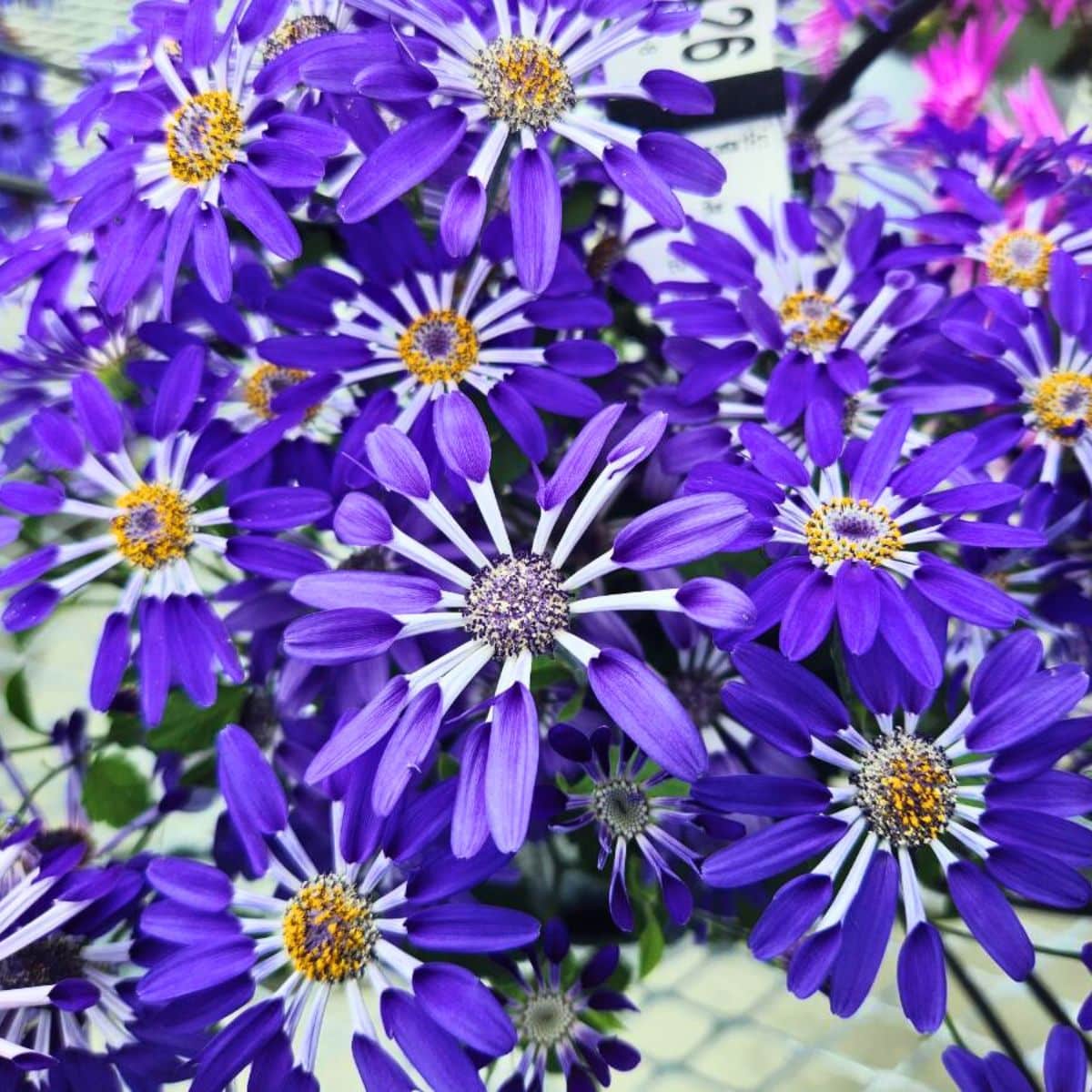
Leave a Reply